
The gifted triple-threats of the USC School Of Theatre have taken on the many challenges of Broadway’s City Of Angels, the Tony-winning Best Musical of 1989, resulting in so high quality a production that the only thing “low” about it is its performers’ average age.
It helps of course that the material is as good as it gets. Cy Coleman’s score is one of his best (and jazziest), David Zippel’s lyrics are clever and witty, and Larry Gelbart’s book is an artfully crafted homage to both detective film noir and Hollywood of the late 1940s.
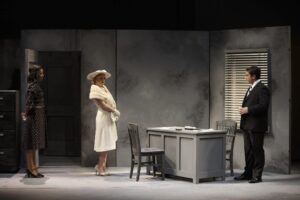 City Of Angels tells two stories simultaneously, one in color and one in black and white, the pair of them stunningly achieved on the stage of USC’s Bing Theatre by a crackerjack team of professional and student designers. There’s the Technicolor tale of a Raymond Chandler/Dashiell Hammett-like novelist assigned to turn his book City Of Angels into a Hollywood flick, all the while dealing with an imperious Jack Warner/Harry Cohn-like producer. Then there’s City Of Angels (The B&W Film Noir), the kind of “down-on-his-luck private dick meets glamorous-but-dangerous femme fatale” mystery that used to star Alan Ladd or Humphrey Bogart opposite Veronica Lake or Lauren Bacall. City Of Angels The Musical casts its two lead actors as Stine (the writer) and Stone (the detective), and the rest of its ensemble mostly in dual roles, one in real life, the other in “reel” life.
City Of Angels tells two stories simultaneously, one in color and one in black and white, the pair of them stunningly achieved on the stage of USC’s Bing Theatre by a crackerjack team of professional and student designers. There’s the Technicolor tale of a Raymond Chandler/Dashiell Hammett-like novelist assigned to turn his book City Of Angels into a Hollywood flick, all the while dealing with an imperious Jack Warner/Harry Cohn-like producer. Then there’s City Of Angels (The B&W Film Noir), the kind of “down-on-his-luck private dick meets glamorous-but-dangerous femme fatale” mystery that used to star Alan Ladd or Humphrey Bogart opposite Veronica Lake or Lauren Bacall. City Of Angels The Musical casts its two lead actors as Stine (the writer) and Stone (the detective), and the rest of its ensemble mostly in dual roles, one in real life, the other in “reel” life.
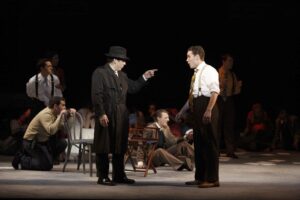 Superbly directed by John Rubinstein (Broadway’s original Pippin and the Best Actor Tony-winning lead of Children Of A Lesser God), City Of Angels stars Matthew McFarland as Stine and Cole Cuomo as Stone, and features Allen Darby as real-life movie producer Buddy Fidler and fictional Hollywood mogul Irwin S. Irving; Amanda Holt as Stine’s unlucky-in-love secretary Donna and Stone’s equally long-suffering secretary Oolie; Carrie St. Louis as Carla Haywood, Buddy’s movie star wife, who plays Alaura Kingsley (the femme fatale who hires Stone) in the movie; Alexandra Arthur as Stine’s girlfriend Gabby, who finds that Stine has cheated on her with Donna, and as lounge singer Bobbi, who loved Stone but cheated on him with Irwin S. Irving; and Alexandra Lowell as Buddy’s daughter Avril, who’ll play Irwin’s missing daughter Mallory in the movie on condition that they don’t kill her off in the first reel.
Superbly directed by John Rubinstein (Broadway’s original Pippin and the Best Actor Tony-winning lead of Children Of A Lesser God), City Of Angels stars Matthew McFarland as Stine and Cole Cuomo as Stone, and features Allen Darby as real-life movie producer Buddy Fidler and fictional Hollywood mogul Irwin S. Irving; Amanda Holt as Stine’s unlucky-in-love secretary Donna and Stone’s equally long-suffering secretary Oolie; Carrie St. Louis as Carla Haywood, Buddy’s movie star wife, who plays Alaura Kingsley (the femme fatale who hires Stone) in the movie; Alexandra Arthur as Stine’s girlfriend Gabby, who finds that Stine has cheated on her with Donna, and as lounge singer Bobbi, who loved Stone but cheated on him with Irwin S. Irving; and Alexandra Lowell as Buddy’s daughter Avril, who’ll play Irwin’s missing daughter Mallory in the movie on condition that they don’t kill her off in the first reel.
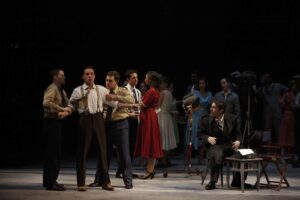 If you’re confused, don’t worry too much about it. Just sit back and embark on as enjoyable a musical theater ride as you’ve can possibly imagine.
If you’re confused, don’t worry too much about it. Just sit back and embark on as enjoyable a musical theater ride as you’ve can possibly imagine.
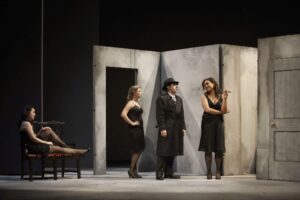 As Stone, Cuomo captures to perfection the hard-boiled style of those classic film noir private dicks, in addition to having one of the most mellifluous speaking voices and best baritone vocal chords in town. A terrific McFarland gives Stine sincerity and heart, and when the young leading man belts out the show’s most dramatic number, “Funny,” get ready to cheer. St. Louis makes for an absolutely stunning Carla/Alaura, and never more so than when duetting “Double Talk” and “The Tennis Song” with Cuomo. Darby plays megalomaniacal Buddy and Irving S. Irving with such color and panache that he threatens to walk away with the show whenever each is onstage. Leading ladies Holt and Arthur have delightful stage presence and melodious pipes, the former stopping the show with “You Can Always Count On Me,” the latter soloing a pair of the show’s best musical numbers, the torchy “With Every Breath I Take” and the bouncy “It Needs Work.” Lowell makes the show’s luscious pair of teen temptresses an alluring duo, and never more so than when warbling a seductive “Lost And Found” in a towel.
As Stone, Cuomo captures to perfection the hard-boiled style of those classic film noir private dicks, in addition to having one of the most mellifluous speaking voices and best baritone vocal chords in town. A terrific McFarland gives Stine sincerity and heart, and when the young leading man belts out the show’s most dramatic number, “Funny,” get ready to cheer. St. Louis makes for an absolutely stunning Carla/Alaura, and never more so than when duetting “Double Talk” and “The Tennis Song” with Cuomo. Darby plays megalomaniacal Buddy and Irving S. Irving with such color and panache that he threatens to walk away with the show whenever each is onstage. Leading ladies Holt and Arthur have delightful stage presence and melodious pipes, the former stopping the show with “You Can Always Count On Me,” the latter soloing a pair of the show’s best musical numbers, the torchy “With Every Breath I Take” and the bouncy “It Needs Work.” Lowell makes the show’s luscious pair of teen temptresses an alluring duo, and never more so than when warbling a seductive “Lost And Found” in a towel.
Director Rubinstein doubles the size of City Of Angels’ Greek/Jazz Chorus, originally the Angel City 4, here the Angel City 8, the better to hear those great Coleman/Yaron Gershovsky vocal arrangements, and the USC octet couldn’t sound better. Richard Storrs makes for a charming lead crooner Jimmy Powers, backed by Samantha Cardenas, Arielle Fishman, Kimberly Hessler, Andrew Johnson, Janelle Patterson, Sean Phillips, Carlye Porrazzo, and Judd Yort.
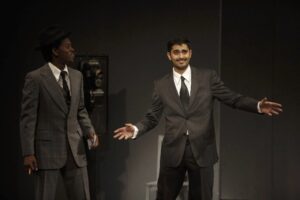 Kapil Talwalkar is a featured player standout as actor Pancho Vargas and Lt. Munoz, who gets the plum assignment of singing the Latin-flavored “All You Have To Do Is Wait,” accompanied by Lee J. Cotton (Yamato), Segun Oluwadele (Mahoney), Brandon Rachal (Commissioner Gaines), and Steven Rigaux (Officer Pasco) doing one heck of a mambo to Lili Fuller’s sparkling choreography. Michael Peha is a young hoot as old coot Luther Kingsley, Steven Miller and Matthew Brown are the hilariously mismatched gangster duo of Big Six and Sonny, and Riley Smith is an amusingly other-worldly Dr. Mandril.
Kapil Talwalkar is a featured player standout as actor Pancho Vargas and Lt. Munoz, who gets the plum assignment of singing the Latin-flavored “All You Have To Do Is Wait,” accompanied by Lee J. Cotton (Yamato), Segun Oluwadele (Mahoney), Brandon Rachal (Commissioner Gaines), and Steven Rigaux (Officer Pasco) doing one heck of a mambo to Lili Fuller’s sparkling choreography. Michael Peha is a young hoot as old coot Luther Kingsley, Steven Miller and Matthew Brown are the hilariously mismatched gangster duo of Big Six and Sonny, and Riley Smith is an amusingly other-worldly Dr. Mandril.
Completing the terrific cast of thirty (five more than the original Broadway production!) are Kevin Herald (Peter Kingsley), Katie Moloney (Bootsie), Steven Pieszchalski (Shoeshine Boy), Katie Porter (Margie), and Haley Willis (Girl/Stand-in).
Musical director Alby Potts (a Scenie winner four years running now) conducts as gorgeous-sounding a nineteen-piece pit orchestra as you’re likely to hear all year, performing Billy Byers’ original Broadway orchestrations.
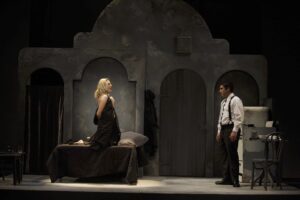 It’s hard to imagine a finer design team than the pro-am foursome united for this production, beginning with LADCC Award winner Don Llewellyn, whose striking scenic design moves seamlessly from black-and-white to living color and back again, that is when the two color palettes aren’t sharing the stage simultaneously. Erin Anderson’s lighting design so perfectly complements Llewellyn’s set that you’d never guess that she’s a USC student, and the same can be said for Theater Design major Manuel Prieto’s bevy of gorgeous late ‘40s costumes, half in b/w and half in all the colors of the rainbow. Ovation and LADCC Award winner Philip G. Allen’s sound design expertise is evident throughout, both in insuring a crystal clear mix of vocals and instrumentals and in the numerous effects heard throughout the performance.
It’s hard to imagine a finer design team than the pro-am foursome united for this production, beginning with LADCC Award winner Don Llewellyn, whose striking scenic design moves seamlessly from black-and-white to living color and back again, that is when the two color palettes aren’t sharing the stage simultaneously. Erin Anderson’s lighting design so perfectly complements Llewellyn’s set that you’d never guess that she’s a USC student, and the same can be said for Theater Design major Manuel Prieto’s bevy of gorgeous late ‘40s costumes, half in b/w and half in all the colors of the rainbow. Ovation and LADCC Award winner Philip G. Allen’s sound design expertise is evident throughout, both in insuring a crystal clear mix of vocals and instrumentals and in the numerous effects heard throughout the performance.
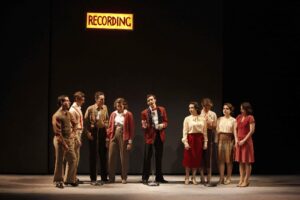 Kudos too to hair and make-up designer Amanda Charney, fight choreographer Edgar Landa, assistant director Luke Kanter, stage manager Taylor Ruge, and the many students and professionals whose contributions backstage and in the orchestra pit help make City Of Angels such a bona fide hit.
Kudos too to hair and make-up designer Amanda Charney, fight choreographer Edgar Landa, assistant director Luke Kanter, stage manager Taylor Ruge, and the many students and professionals whose contributions backstage and in the orchestra pit help make City Of Angels such a bona fide hit.
It’s been six years since this City Of Angels we call home has seen a big stage professional production of City Of Angels. That was Reprise’s 2006 revival, and with theater economics the way they are, it’s hard to imagine any company attempting another major production any time soon. This is just one reason not to miss City Of Angels on the USC campus. As for the many others, see the above review for ample proof that this is one student production not to be missed.
Bing Theatre, University Of Southern California, Los Angeles.
www.usc.edu/spectrum
–Steven Stanley
March 29, 2012


 Since 2007, Steven Stanley's StageSceneLA.com has spotlighted the best in Southern California theater via reviews, interviews, and its annual StageSceneLA Scenies.
Since 2007, Steven Stanley's StageSceneLA.com has spotlighted the best in Southern California theater via reviews, interviews, and its annual StageSceneLA Scenies.







 COPYRIGHT 2024 STEVEN STANLEY :: DESIGN BY
COPYRIGHT 2024 STEVEN STANLEY :: DESIGN BY